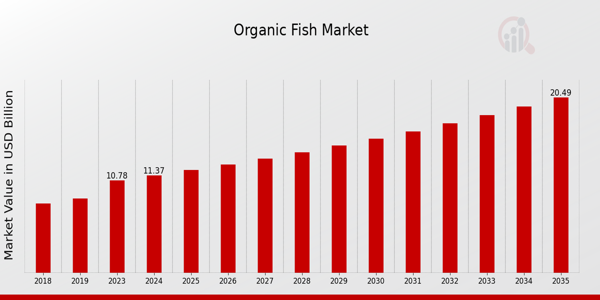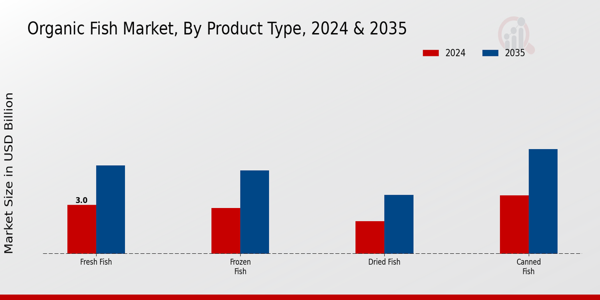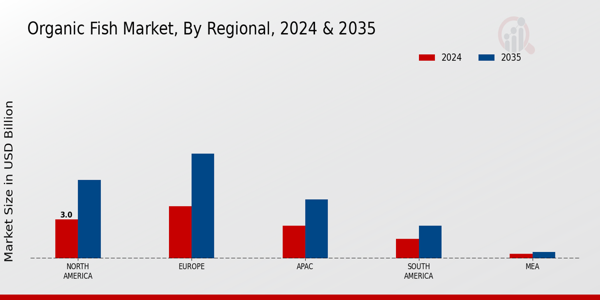Global Organic Fish Market Overview
Organic Fish Market Size was estimated at 10.78 (USD Billion) in 2023. The Organic Fish Industry is expected to grow from 11.37(USD Billion) in 2024 to 20.5 (USD Billion) by 2035. The Organic Fish Market CAGR (growth rate) is expected to be around 5.5% during the forecast period (2025 - 2035).

Source: Primary Research, Secondary Research, MRFR Database and Analyst Review
Key Organic Fish Market Trends Highlighted
Increasing consumer awareness about nutrition and sustainability drives the Organic Fish Market. Health-conscious individuals favor organic fish due to its perceived benefits over conventional options. The rising demand for high-quality seafood that is environmentally friendly has led to significant interest in organic fish farming practices. This shift is supported by a growing number of certifications assuring consumers of the product's organic status. Additionally, government regulations that encourage sustainable fishing practices further drive the growth of this market. Opportunities abound in the organic fish market as consumer preferences shift toward healthier dietary choices.The increasing demand can be satisfied by extending distribution channels, such as internet sites and specialty supermarkets. Creating fresh organic fish items, including frozen and ready-to-eat meals, may help draw in more clients. The industry may grow in unexplored areas as more people learn about the health advantages of eating organic fish. The sustainability movement may pave the way for creative aquaculture techniques. Customers want to know where their food comes from, and recent trends show a significant preference for local and traceable seafood procurement. The growing popularity of plant-based diets is impacting the market for organic fish as consumers become more aware of the benefits of fish as a protein substitute.Additionally, traditional companies are now able to access the organic market because of the growing number of partnerships between conventional and organic fish farms. This change reflects a broader trend toward increased seafood supply chain openness, which is in line with changing customer demands for environmental responsibility, safety, and health. The global market for organic fish essentially sits at the nexus of innovation, sustainability, and health.
Organic Fish Market Drivers
Increasing Demand for Healthy and Sustainable Food Options
The Organic Fish Market Industry is witnessing a robust increase in demand for healthy and sustainable food options among consumers. As more individuals become health-conscious, they are leaning towards organic and natural food sources that promise better nutritional value. Organic fish, raised without harmful chemicals or antibiotics, has emerged as a preferred choice for health-aware consumers. The growing awareness of the health benefits associated with consuming organic fish, such as the rich content of omega-3 fatty acids and essential nutrients, drives consumers to seek these products over conventional alternatives.Furthermore, sustainability is now a significant concern for consumers. The Organic Fish Market Industry caters to this demand by promoting fish farming practices that are environmentally friendly, reducing pollution and overfishing concerns. This trend is supported by the rise of movements advocating for clean eating and sustainable sourcing, encouraging retailers and food service providers to expand their offerings in organic fish. The projected growth in market value underscores the need for sustainable practices and the increasing appetite for organic products which contribute positively to the consumers' health and the environment.
Government Regulations and Certifications
The Organic Fish Market Industry is significantly influenced by growing government regulations and certifications aimed at ensuring food safety and promoting organic practices. Many countries are implementing stricter guidelines for fish farming, focusing on sustainability and health standards. These regulations not only enhance consumer trust but also incentivize organic fish producers to maintain high production standards. The certifications associated with organic fish production serve as important market drivers, as they assure consumers about the quality and safety of the products they purchase.
Rising Awareness of Environmental Issues
The increasing awareness of environmental issues among consumers is shaping the Organic Fish Market Industry. People are becoming more conscious of the effects of overfishing, habitat degradation, and pollution on marine ecosystems. As a result, consumers are actively seeking organic fish options that promote sustainable fishing practices. The emphasis on eco-friendly sourcing and production methods not only aligns with consumer values but also supports the global effort to protect aquatic environments, which is expected to stimulate market growth further.
Organic Fish Market Segment Insights
Organic Fish Market Product Type Insights
The Organic Fish Market revenue showcases significant growth within the Product Type segment, reflecting changing consumer preferences toward healthier and more sustainable food options. In 2024, the market is valued at 11.37 USD Billion, and this valuation is set to increase considerably by 2035. Among the various categories, Fresh Fish stands out with a valuation of 3.0 USD Billion in 2024, which is indicative of consumer demand for fresh, high-quality seafood products. This segment is critical as fresh fish is often perceived as the most natural source of protein, driving its popularity in both retail and food service sectors.
Following closely, Frozen Fish is valued at 2.8 USD Billion in 2024; its preservation method has made it a popular choice for consumers seeking long shelf life without sacrificing nutritional value. This segment allows for the convenience of stocking fish products and is favored by households as well as restaurants.
Dried Fish held a value of 2.0 USD Billion in 2024; this category is essential for regions where refrigeration is a challenge, thus ensuring fish products can be stored over extended periods. The growing inclination towards ethnic cuisines has also boosted the demand for dried fish, making it a significant player in the market. Meanwhile, the Canned Fish segment, valued at 3.57 USD Billion in 2024, dominates the market due to its versatility and ease of storage. Canned fish products are not only convenient but are increasingly being recognized for their health benefits, as they often contain omega-3 fatty acids and other vital nutrients. The solid growth in these product types is supported by a rise in health consciousness among consumers, pushing the trend toward organic options.
The Organic Fish Market statistics clearly underline how each of these categories fulfills different consumer needs, thus contributing collectively to market expansion with opportunities for brand differentiation and innovation. Overall, this segment reflects a dynamic evolution shaped by changing dietary habits and growing awareness surrounding sustainable seafood sourcing practices.

Organic Fish Market Distribution Channel Insights
The Organic Fish Market, particularly in the Distribution Channel segment, showcased a market valuation of 11.37 USD Billion in 2024, reflecting a steady demand for organic seafood. The segmentation within this channel includes various avenues such as supermarkets, online retail, specialty stores, and restaurants, each playing a crucial role in market dynamics. Supermarkets dominate the distribution landscape due to their extensive reach and consumer familiarity. Online retail has gained significant traction, especially among younger demographics who seek convenience and variety.Specialty stores cater to health-conscious consumers who prioritize quality and sourcing transparency, while restaurants contribute substantially by incorporating organic fish into their menus, responding to the growing trend of sustainable dining. The interplay between these channels highlights an evolving market landscape influenced by increasing consumer awareness regarding healthy eating, the environmental impact of fishing practices, and a growing preference for organic products. Overall, the Organic Fish Market revenue is poised for substantial growth as these distribution channels evolve and adapt to emerging consumer needs and preferences.
Organic Fish Market Form Insights
The Organic Fish Market is experiencing steady growth, with a valuation reaching 11.37 USD Billion in 2024, projected to increase significantly over the years. This market is segmented into various forms, including Whole Fish, Fillets, Steaks, and Pieces, each offering unique advantages. Whole Fish is prominent, often preferred for its freshness and versatility in culinary uses. Fillets cater to the demand for convenience and quick cooking options, making them very popular among consumers. Steaks, known for their thick cut, are favored for grilling and upscale dining experiences, leading to a significant share of the market.Lastly, Pieces are gaining traction for their adaptability in various dishes, appealing to both restaurants and home cooks. The Organic Fish Market revenue reflects a robust consumer preference for organic options driven by health considerations and sustainable sourcing. As market growth continues, key drivers include rising awareness about nutrition and environmental impact, while challenges lie in sourcing and maintaining supply chain integrity. The Organic Fish Market statistics indicate a promising future where opportunities exist for innovative product offerings that meet evolving consumer tastes.
Organic Fish Market End-Use Insights
The Organic Fish Market's end-use segment is diverse, incorporating applications across Household, Commercial, and Food Services. As of 2024, the overall market was valued at 11.37 USD Billion, showcasing the steady growth and rising consumer preferences for organic fish products. Households represent a considerable portion of this market, driven by increasing health-consciousness among consumers seeking sustainable and nutritious food options. Meanwhile, the Commercial sector, which includes retailers and wholesalers, plays a critical role in expanding the market reach due to rising demand from consumers who prioritize organic food in their shopping.Additionally, the Food Services area, encompassing restaurants and catering services, is significant as it reflects growing trends toward healthier menu options. The emergence of eco-friendly dining experiences is challenging traditional food service offerings, compelling operators to source organic fish, often dominating the market in terms of preference. The overall Organic Fish Market revenue is projected to reach 20.5 USD Billion by 2035, underscoring a positive trajectory driven by these influential segments within the industry.
Organic Fish Market Regional Insights
The Organic Fish Market shows a robust structure across its regional segmentation, with North America and Europe playing significant roles. In 2024, North America was valued at 3.0 USD Billion and is expected to grow to 6.0 USD Billion by 2035, showcasing its dominance in the market. Europe followed closely, holding a valuation of 4.0 USD Billion in 2024 and projected to reach 8.0 USD Billion in 2035, indicating its major share due to consumer preferences for organic fish products. The APAC region accounted for a valuation of 2.5 USD Billion in 2024, with an increase to 4.5 USD Billion anticipated by 2035, reflecting the growing health consciousness and demand for organic food among its population.South America, starting at 1.5 USD Billion in 2024 and expected to grow to 2.5 USD Billion by 2035, represents an emerging market with potential due to a rise in organic farming practices. Meanwhile, the MEA region, with a lower valuation of 0.37 USD Billion in 2024, increasing to 0.5 USD Billion by 2035, faces challenges in market penetration but still contributes to the diversification of the Organic Fish Market revenue streams. Overall, the market growth is driven by increasing health concerns and rising disposable incomes, enabling a shift towards organic options across these regions.

Organic Fish Market Key Players and Competitive Insights
The Organic Fish Market has been witnessing remarkable growth due to increased consumer awareness regarding the health benefits associated with organic food sources and sustainable fishing practices. As demand for organic products rises, so does the competition among established players in the market. Companies are increasingly focusing on organic certifications, sustainable sourcing, and environmentally friendly practices as key differentiators. This competitive landscape highlights a push for innovation, quality improvement, and market expansion to cater to discerning consumers who seek transparency in sourcing and production processes. With regulatory frameworks supporting organic production and evolving consumer preferences, the market continues to attract various players vying for market share and customer loyalty.Nissui has established a substantial presence in the Organic Fish Market by leveraging its strong foundations in seafood processing and distribution. The company has garnered a reputation for high-quality fish products, positioning itself as a trusted source of organic seafood offerings. Nissui's commitment to sustainable fishing practices is a significant strength, as consumers increasingly demand ethically sourced seafood. This commitment is further bolstered by the company's continuous investment in research and development, enabling them to innovate and enhance their organic product lines. Nissui's robust distribution network and existing market relationships further reinforce its competitive edge, allowing it to efficiently meet growing consumer demand while maintaining high standards of quality and sustainability.Sanderson Farms, primarily recognized for its poultry production, is making meaningful strides in the Organic Fish Market. The company's entry into this segment is underscored by its operational efficiency and dedication to quality assurance. Sanderson Farms benefits from its extensive experience in the food processing industry, applying best practices from poultry to fish production. This strategic expansion allows the company to utilize its established supply chains and distribution networks effectively. Additionally, Sanderson Farms emphasizes sustainable farming practices, which resonate well with the value-driven consumer base within the organic sector. The company's focus on maintaining stringent quality control measures ensures that it provides organic fish products that align with consumer expectations for premium offerings, thereby enhancing its competitive position within the market.
Key Companies in the Organic Fish Market Include
- Nissui
- Sanderson Farms
- Leroy Seafoods
- Ocean Harvest Technology
- Mowi ASA
- Bakkafrost
- Royal Greenland
- Maruha Nichiro Corporation
- Austevoll Seafood
- Clear Springs Foods
- Fish Imports
- Ocean Beauty Seafoods
- Thai Union Group
- Cermaq
- High Liner Foods
Organic Fish Market Industry Developments
The Organic Fish Market has been witnessing significant developments recently. Companies like Mowi ASA and Leroy Seafoods have expanded their production capabilities to meet the increasing consumer demand for sustainable seafood, emphasizing eco-friendly farming practices. The Thai Union Group has also announced new initiatives aimed at enhancing traceability in their supply chain, which is becoming increasingly important to consumers. In terms of market dynamics, firms such as Sanderson Farms and Royal Greenland are reportedly experiencing growth in market valuation due to favorable consumer preferences for organic and sustainably sourced fish products. Merger and acquisition activities have been noted within this space, such as Austevoll Seafood's strategic expansion plans and Bakkafrost's recent acquisitions, which highlight a trend towards consolidation within the sector as companies seek to enhance their market presence and operational efficiencies. Clear Springs Foods and Ocean Beauty Seafoods are also focusing on diversifying their offerings while aligning with the growing emphasis on health and wellness in food choices. Overall, the landscape of the Organic Fish Market reflects a continuous adaptation to changing consumer preferences and environmental considerations, driving growth and innovation within the industry.
-
Organic Fish Market Segmentation Insights
-
Organic Fish Market Product Type Outlook
- Fresh Fish
- Frozen Fish
- Dried Fish
- Canned Fish
-
Organic Fish Market Distribution Channel Outlook
- Supermarkets
- Online Retail
- Specialty Stores
- Restaurants
-
Organic Fish Market Form Outlook
- Whole Fish
- Fillets
- Steaks
- Pieces
-
Organic Fish Market End-Use Outlook
- Household
- Commercial
- Food Services
-
Organic Fish Market Regional Outlook
-
North America
-
Europe
-
South America
-
Asia-Pacific
-
Middle East and Africa
| Report Attribute/Metric |
Details |
| Market Size 2023 |
10.78(USD Billion) |
| Market Size 2024 |
11.37(USD Billion) |
| Market Size 2035 |
20.5(USD Billion) |
| Compound Annual Growth Rate (CAGR) |
5.5% (2025 - 2035) |
| Report Coverage |
Revenue Forecast, Competitive Landscape, Growth Factors, and Trends |
| Base Year |
2024 |
| Market Forecast Period |
2025 - 2035 |
| Historical Data |
2019 - 2023 |
| Market Forecast Units |
USD Billion |
| Key Companies Profiled |
Nissui, Sanderson Farms, Leroy Seafoods, Ocean Harvest Technology, Mowi ASA, Bakkafrost, Royal Greenland, Maruha Nichiro Corporation, Austevoll Seafood, Clear Springs Foods, Fish Imports, Ocean Beauty Seafoods, Thai Union Group, Cermaq, High Liner Foods |
| Segments Covered |
Product Type, Distribution Channel, Form, End Use, Regional |
| Key Market Opportunities |
Increased consumer health awareness, Rising demand for sustainable seafood, Expansion of e-commerce platforms, Growth in organic certifications, and Collaboration with local fisheries. |
| Key Market Dynamics |
sustainability trends, consumer health awareness, regulatory frameworks, production costs, supply chain complexities |
| Countries Covered |
North America, Europe, APAC, South America, MEA |
Frequently Asked Questions (FAQ) :
The Organic Fish Market was valued at 11.37 billion USD in 2024.
By 2035, the Organic Fish Market is anticipated to reach a valuation of 20.5 billion USD.
The expected compound annual growth rate (CAGR) for the Organic Fish Market from 2025 to 2035 is 5.5%.
Fresh Fish is valued at 3.0 billion USD in 2024 and is expected to reach 5.4 billion USD by 2035.
Major players in the Organic Fish Market include Nissui, Mowi ASA, and Thai Union Group, among others.
The market size for Canned Fish is projected to reach 6.4 billion USD by 2035.
Opportunities in the Organic Fish Market include rising consumer awareness of healthy eating and sustainable practices.
Challenges affecting the Organic Fish Market could include environmental regulations and supply chain disruptions.

















